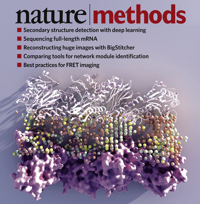Filter
Associated Lab
- Betzig Lab (1) Apply Betzig Lab filter
- Cardona Lab (1) Apply Cardona Lab filter
- Clapham Lab (1) Apply Clapham Lab filter
- Darshan Lab (1) Apply Darshan Lab filter
- Druckmann Lab (1) Apply Druckmann Lab filter
- Dudman Lab (2) Apply Dudman Lab filter
- Harris Lab (1) Apply Harris Lab filter
- Keller Lab (3) Apply Keller Lab filter
- Lavis Lab (2) Apply Lavis Lab filter
- Lippincott-Schwartz Lab (3) Apply Lippincott-Schwartz Lab filter
- Liu (Zhe) Lab (1) Apply Liu (Zhe) Lab filter
- Looger Lab (1) Apply Looger Lab filter
- Singer Lab (2) Apply Singer Lab filter
- Spruston Lab (1) Apply Spruston Lab filter
- Sternson Lab (1) Apply Sternson Lab filter
- Svoboda Lab (1) Apply Svoboda Lab filter
- Tillberg Lab (1) Apply Tillberg Lab filter
Associated Project Team
Associated Support Team
Publication Date
- September 30, 2019 (2) Apply September 30, 2019 filter
- September 25, 2019 (2) Apply September 25, 2019 filter
- September 23, 2019 (2) Apply September 23, 2019 filter
- September 19, 2019 (1) Apply September 19, 2019 filter
- September 16, 2019 (1) Apply September 16, 2019 filter
- September 10, 2019 (1) Apply September 10, 2019 filter
- September 4, 2019 (1) Apply September 4, 2019 filter
- September 2, 2019 (2) Apply September 2, 2019 filter
- September 1, 2019 (3) Apply September 1, 2019 filter
- Remove September 2019 filter September 2019
- Remove 2019 filter 2019
15 Janelia Publications
Showing 11-15 of 15 resultsIdiosyncratic tendency to choose one alternative over others in the absence of an identified reason, is a common observation in two-alternative forced-choice experiments. It is tempting to account for it as resulting from the (unknown) participant-specific history and thus treat it as a measurement noise. Indeed, idiosyncratic choice biases are typically considered as nuisance. Care is taken to account for them by adding an ad-hoc bias parameter or by counterbalancing the choices to average them out. Here we quantify idiosyncratic choice biases in a perceptual discrimination task and a motor task. We report substantial and significant biases in both cases. Then, we present theoretical evidence that even in idealized experiments, in which the settings are symmetric, idiosyncratic choice bias is expected to emerge from the dynamics of competing neuronal networks. We thus argue that idiosyncratic choice bias reflects the microscopic dynamics of choice and therefore is virtually inevitable in any comparison or decision task.
Lattice light-sheet microscopy (LLSM) is valuable for its combination of reduced photobleaching and outstanding spatiotemporal resolution in 3D. Using LLSM to image biosensors in living cells could provide unprecedented visualization of rapid, localized changes in protein conformation or posttranslational modification. However, computational manipulations required for biosensor imaging with LLSM are challenging for many software packages. The calculations require processing large amounts of data even for simple changes such as reorientation of cell renderings or testing the effects of user-selectable settings, and lattice imaging poses unique challenges in thresholding and ratio imaging. We describe here a new software package, named ImageTank, that is specifically designed for practical imaging of biosensors using LLSM. To demonstrate its capabilities, we use a new biosensor to study the rapid 3D dynamics of the small GTPase Rap1 in vesicles and cell protrusions.
Neurons and glia operate in a highly coordinated fashion in the brain. Although glial cells have long been known to supply lipids to neurons via lipoprotein particles, new evidence reveals that lipid transport between neurons and glia is bidirectional. Here, we describe a co-culture system to study transfer of lipids and lipid-associated proteins from neurons to glia. The assay entails culturing neurons and glia on separate coverslips, pulsing the neurons with fluorescently labeled fatty acids, and then incubating the coverslips together. As astrocytes internalize and store neuron-derived fatty acids in lipid droplets, analyzing the number, size, and fluorescence intensity of lipid droplets containing the fluorescent fatty acids provides an easy and quantifiable measure of fatty acid transport. © 2019 The Authors.
Light-sheet imaging of cleared and expanded samples creates terabyte-sized datasets that consist of many unaligned three-dimensional image tiles, which must be reconstructed before analysis. We developed the BigStitcher software to address this challenge. BigStitcher enables interactive visualization, fast and precise alignment, spatially resolved quality estimation, real-time fusion and deconvolution of dual-illumination, multitile, multiview datasets. The software also compensates for optical effects, thereby improving accuracy and enabling subsequent biological analysis.
The cyanobacterial culture HT-58-2, composed of a filamentous cyanobacterium and accompanying community bacteria, produces chlorophyll a as well as the tetrapyrrole macrocycles known as tolyporphins. Almost all known tolyporphins (A-M except K) contain a dioxobacteriochlorin chromophore and exhibit an absorption spectrum somewhat similar to that of chlorophyll a. Here, hyperspectral confocal fluorescence microscopy was employed to noninvasively probe the locale of tolyporphins within live cells under various growth conditions (media, illumination, culture age). Cultures grown in nitrate-depleted media (BG-11 vs. nitrate-rich, BG-11) are known to increase the production of tolyporphins by orders of magnitude (rivaling that of chlorophyll a) over a period of 30-45 days. Multivariate curve resolution (MCR) was applied to an image set containing images from each condition to obtain pure component spectra of the endogenous pigments. The relative abundances of these components were then calculated for individual pixels in each image in the entire set, and 3D-volume renderings were obtained. At 30 days in media with or without nitrate, the chlorophyll a and phycobilisomes (combined phycocyanin and phycobilin components) co-localize in the filament outer cytoplasmic region. Tolyporphins localize in a distinct peripheral pattern in cells grown in BG-11 versus a diffuse pattern (mimicking the chlorophyll a localization) upon growth in BG-11. In BG-11, distinct puncta of tolyporphins were commonly found at the septa between cells and at the end of filaments. This work quantifies the relative abundance and envelope localization of tolyporphins in single cells, and illustrates the ability to identify novel tetrapyrroles in the presence of chlorophyll a in a photosynthetic microorganism within a non-axenic culture.

